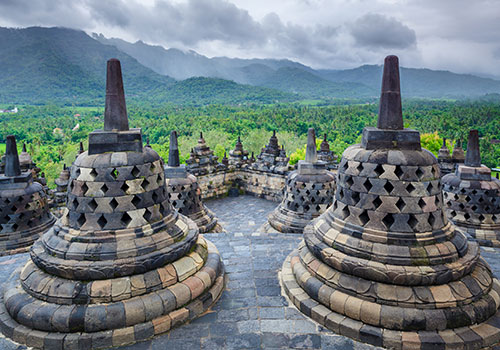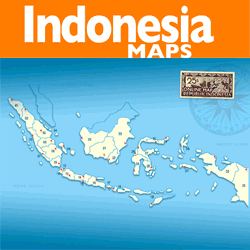Borobudur Temple

Borobudur is the biggest Buddhist temple in the ninth century measuring 123 x 123 meters. It is located at Magelang, 90-km southeast of Semarang, or 42-km northwest of Yogyakarta. Borobudur temple is the one of the best-preserved ancient monument in Indonesia that are most frequently visited by over a million domestic as well as foreign visitors. It also had been acclaimed by the world as a cultural heritage main kind. The architectural style has no equal through out the world. It was completed centuries before Angkor Wat in Kamboja. Borobudur is one of the world's most famous temples; it stands majestically on a hilltop overlooking lush green fields and distant hills. Borobudur is built of gray andesite stone. It rises to seven terraces, each smaller than the one below it. The top is the Great Stupa, standing 40 meters above the ground. The walls of the Borobudur are sculptured in bas-reliefs extending over a total length of six kilometers. It has been hailed as the largest and most complete ensemble of Buddhist relieves in the world, unsurpassed in artistic merit and each scene an individual masterpiece.
Borobudur temple built in the eighth century by the Cailendra dynasty, is believed to have been derived from the Sanskrit words "Vihara Buddha Uhr" the Buddhist Monastery on the hill. Borobudur is a terraced temple surmounted by stupas, or stone towers; the terraces resemble Indonesian burial foundations, indicating that Borobudur was regarded as the symbol of the final resting place of its founder, a Syailendra, who was united after his death with the Buddha. The Prambanan temple complex is also associated with a dead king. The inscription of 856 mentions a royal funeral ceremony and shows that the dead king had joined Shiva, just as the founder of the Borobudur monument had joined the Buddha. Divine attributes, however, had been ascribed to kings during their lifetimes. A Mahayana inscription of this period shows that a ruler was said to have the purifying powers of a bodhisattva, the status assumed by the ruler of Shrivijaya in the 7th century; a 9th-century Shaivite inscription from the Kedu Plain describes a ruler as being "a portion of Shiva."
The Borobudur was in danger of collapsing as its stone statues and stone cancer, moss and lichen affected bas-reliefs. But, the monument has been completely restored and was officially opened by the President on 23rd February 1983. The restoration took eight years to complete, funded by the Government of Indonesia with aid from the UNESCO and donations from private citizens as well as from foreign governments.
The visitors have the option of going by taxi or public bus to reach this temple. Public transportation is available from the bus terminal. From that point visitors can hire becaks or horse carts, or walk the rest of the way to the monument. A large parking area is available not far from the monument, so private cars and buses can park in this area.

Indonesia’s Heritage Collection: Van Der Wijck Fort -Kebumen
One of the many Dutch heritage forts, Van Der Wijck Fort is unique because the entire building is made of red brick. You’ve seen? This fort with an octagonal plan looks more charming with its red color, compared to Dutch forts which are generally colorless or white. It looks like the fort from the front and inside uses red bricks, but still with the characteristics of a Dutch fort in Indonesia which has a large building structure, such as windows, doors and rooms. With an area of 3606,625 square meters,…
10 Most Unique Tourist Villages in Magelang, Makes You Don’t Want to Go Home
Magelang has a number of temples as the favorite tourist destinations. Besides Borobudur, you can visit several other places, such as tourist villages. There are several tourist villages around Borobudur Temple with a unique and interesting atmosphere. In addition to saving nature, you can also get to know the culture behind it. Temanggung VillageTemanggung Village was viral because it was called Nepal van Java. The view of the village at the foot of Mount Sumbing is really epic. Tanjungsari VillageIf you are interested in the process of making honey, you…
Amazing Tourist Destinations in Jepara, Central Java
Punuk Sapi BeachPunuk Sapi Beach is also popularly known as Pantai Lemah Abang which means “red land beach”. It is named so because this beach is indeed filled with mounds to hills with red soil that at first glance looks like a cow’s hump (punuk sapi is cow’s hump in English). This beach has black sand, but it is also beautiful like the white sand beaches. There are hammocks and swings that you can use to relax, as well as take pictures from a height. This beach is located in…
Arjuna Temple, A Relic of Hindu in the Ancient Mataram Kingdom
Arjuna Temple complex is the most photographed and visited of the surviving temples on the Dieng Plateau. Situated just a few hundred meter from the homestays in Dieng village, they are an obvious first stop on a tour of the sights in the area. Though they are far from the most imposing of Javanese temples, they are the earliest surviving Hindu temples in Central Java, so they are of great importance historically. Built a century or two before the great temples around Yogyakarta and Magelang, they mark the original phase…









